Page content
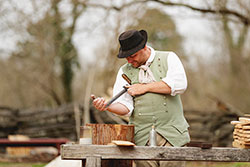
Carpenters work on the construction of a saw house in the new Carpenters' Yard.
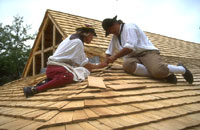
Carpenters lay shingles on the roof of a shed near Shields Tavern in The Revolutionary City.
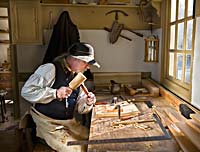
Precision work is done with the natural light streaming through the window.
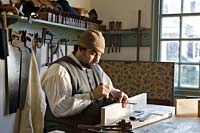
Tools of the carpenter and joiner help create future structures.
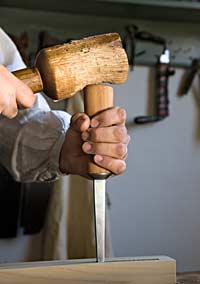
A carpenter works in the Joinery.
Carpenter
and Joiner
In a century when most structures were built from wood, no tradesmen were more useful than the carpenter and joiner. The main business of the colonial carpenter was to cut and join timber and board into sturdy wooden homes and shops. Joinery is one of the specializations of carpentry. As Williamsburg blossomed, the demand for new homes, shops, outbuildings stables, sheds, and their repair grew at a rapid pace.
Carpenters and Joiners built city of Williamsburg
The city was literally hammered together in the 1700s by men like Benjamin Powell, John Wheatley, James Morris, Christopher Ford, and dozens of other carpenters whose names appear on the ledgers of building trades customers. Much of the work was accomplished by slaves that such builders owned or hired. Large numbers of slaves – skilled and unskilled – helped construct the colonial capital. Carpenters were also hired to do repair work build additions to existing structures, or to make smokehouses, dairies, necessaries, and other outbuildings. Brick structures, too, required finishing work and routine maintenance.
The carpenter worked from a building's foundation to its roof ridge. He laid floors, chiseled mortise-and-tenon joints, framed walls, raised rafters, carved moldings, hung doors, and nailed weatherboard. Carpenters sometimes acquired building materials from less-skilled laborers, frequently using planks cut from logs by a sawyer and shingles made by slaves at a building site. A joiner would finish interiors by joining together pieces of wood and might work on door and window frames and staircases and other wood pieces within a house or building.
Common carpentry tools included:
- saw
- broadax
- hammer
- awl
- mallet
- plane
- scribe
- drawknife
- gimlet
- froe
Carpenters built with:
- oak
- locust
- tulip
- poplar
- yellow pine
- cypress
- juniper
- oak chestnut
Colonial carpentry survives in original 18th-century buildings
Durable examples of the work of carpenters may be seen in Colonial Williamsburg's 88 original 18th-century buildings. None, perhaps, is finer than the Peyton Randolph House, where carpenters reconstructed the site's outbuildings. Currently, the Historic Trades carpenters are using 18th-century tools and techniques at the carpenter's yard and the joiners are located at the Joinery.
Learn more:
- Reconstruction at Peyton Randolph House
- Tools
- Great Hopes Plantation
- The Anderson Armoury Reconstruction
